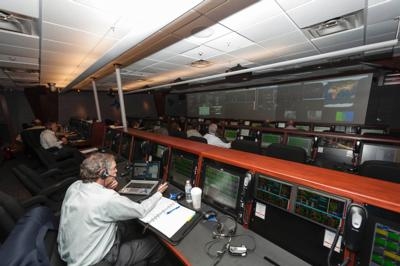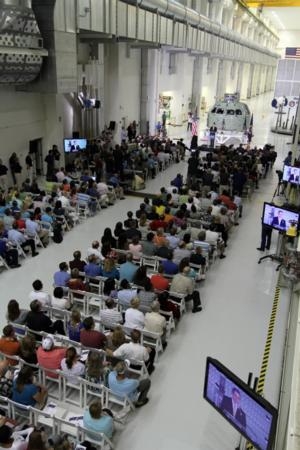Support Staff Ramping Up As Launch Day Nears
The upcoming flight test of NASA's Orion spacecraft will be a mission of firsts. This new crew vehicle, making its debut on Exploration Flight Test-1, will become the first of its kind in four decades to venture beyond low-Earth orbit. The mission also marks the first time a spacecraft designed to carry humans will be lofted to orbit by a modern-day expendable launch vehicle.

Orion will fly aboard a United Launch Alliance (ULA) Delta IV Heavy rocket. NASA's Launch Services Program (LSP), based at Kennedy Space Center in Florida, specializes in the management of missions flying on expendable rockets, single-use vehicles that aren't reused. The program is providing its expertise in an advisory capacity for Orion's first flight.
"An advisory role really can be whatever the customer wants it to be, depending on what the needs are," explained John Calvert, a mission manager in the program's Flight Projects Office.
LSP's lead launch site integration manager, Mark Shugg, explained that Johnson Space Center's Flight Test Management Office contacted LSP about four years ago to find out if the program could help.
"They recognized us as the agency's leading subject matter expert in the field of launching spacecraft on expendable launch vehicles and providing customers with payload processing facilities for hazardous operations," Shugg said.
In the case of Orion's first flight, LSP agreed to provide specific Kennedy facilities, ground support equipment, communications and video capabilities, and computer modeling of the vehicle's guidance, navigation and control (GNC) system.
Asked which key areas could have the biggest impact on mission success, the program identified guidance, navigation, and control of the vehicle as essential. Flight test managers requested Independent Verification and Validation, or IV&V, to build confidence in the unique configuration of the Delta IV rocket for this particular mission.
Jon Bauschlicher leads the GNC group, part of the Flight Dynamics Branch in LSP's Flight Analysis Division. The group took on the massive IV&V computer modeling effort for this test.
"We set about building computer models of the rocket and its systems from liftoff through orbit insertion -- that part of the flight when the rocket's GNC system is active -- factoring in the timing and effects of possible disturbances like wind gusts or variations in engine performance," Bauschlicher explained.
They'll present their results to the Flight Test Management Office through a formal review process.

"We've had four or five engineers working on this full time, building up computer models that predict guidance, navigation, and control system performance while flying this mission and comparisons to ULA's predictions of GNC system performance," Bauschlicher said. "I give full credit to the team for working weekends and off-hours in addition to their standard workloads."
The Orion spacecraft structure arrived at Kennedy in 2012 from NASA's Michoud Assembly Facility in New Orleans and other parts and components arrived from all over the country. While Lockheed Martin has assembled these to build the crew and service modules in Kennedy's Operations and Checkout Building, LSP has been working to prepare the center's Payload Hazardous Servicing Facility for Orion's arrival this fall.
"In our typical missions, the spacecraft is shipped in from elsewhere. This is unique, because it's the first time the offsite factory is here at Kennedy," Shugg explained.
Once United Launch Alliance transports Orion into the servicing facility, though, LSP has a hands-on role in ensuring Lockheed Martin gets the right support during hazardous activities such as pressurizing tanks, ammonia servicing, and loading of hypergolic fuels.
LSP's Communications and Telemetry Group also is providing communications, telemetry, data, video and voice recording during key processing milestones and throughout the flight.
Cape Canaveral Air Force Station's Hangar AE is supporting Johnson Space Center's Mission Management Team with a series of joint integrated simulations. Combined, the rehearsals will take the launch team through the entire mission sequence, from six hours prior to liftoff all the way to the spacecraft's splashdown and recovery.
The simulations give the look and feel of a real launch day, according to Lois Clutter, an LSP Ground Data Systems aerospace technologist supporting Orion's first flight. Playback of earlier Delta IV launches add to the authenticity. Each practice run also gives launch personnel the opportunity to figure out what they need during the countdown -- before they truly need it.
"These integrated 'sims' are helping the Mission Management Team decide which voice, video and data they need to support their jobs," Clutter said.
During flight, LSP will separate the spacecraft telemetry data from that of the rocket, then provide both to Johnson's Mission Control Center.
A relatively low number of LSP team members have worked on Orion's first flight, although support has varied over time and is ramping up as launch approaches, Calvert explained.
"But dozens of our folks have put their fingerprints on the mission in some way," he added.
When launch day arrives, LSP's role will shift from advising to monitoring, following along with the countdown and watching to see how the mission progresses. In Hangar AE, Clutter will be stationed at the Mission Operations Director's console should anyone on the launch team encounter a problem with their console's sound, video, data or communications.
"This flight will be complete in less than a day. In the course of one or two work shifts, we'll see the beginning, middle and end of this mission," Calvert pointed out. "We usually high-five at spacecraft separation; in this case, it will be after the successful Orion reentry and splashdown."
"This flight is so important because it’s the next generation," Clutter said. "This is history."
(Images provided by NASA. Top: Launch personnel gather inside the Mission Director’s Center in Hangar AE for a joint integrated simulation of Orion’s first flight test. Bottom: Kennedy Space Center Director Robert Cabana addresses the audience in Kennedy's Operations and Checkout Building high bay for an event marking the arrival of the Orion capsule.)
 ANN's Daily Aero-Term (05.01.24): Say Altitude
ANN's Daily Aero-Term (05.01.24): Say Altitude ANN's Daily Aero-Linx (05.01.24)
ANN's Daily Aero-Linx (05.01.24) Classic Aero-TV: Korean War Hero Twice Reborn
Classic Aero-TV: Korean War Hero Twice Reborn Airborne 04.29.24: EAA B-25 Rides, Textron 2024, G700 Deliveries
Airborne 04.29.24: EAA B-25 Rides, Textron 2024, G700 Deliveries Airborne Affordable Flyers 05.02.24: Bobby Bailey, SPRG Report Cards, Skydive!
Airborne Affordable Flyers 05.02.24: Bobby Bailey, SPRG Report Cards, Skydive!




